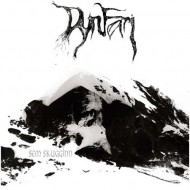 I’ve been very lucky recently with Icelandic metal, having been fortunate enough to review albums by Kontinuum and Fortid. Dynfari are also from “The Land of Ice and Fire”, and judging by the fact that this 9 track album has well over 70 minutes of material, they have plenty to tell us about.
I’ve been very lucky recently with Icelandic metal, having been fortunate enough to review albums by Kontinuum and Fortid. Dynfari are also from “The Land of Ice and Fire”, and judging by the fact that this 9 track album has well over 70 minutes of material, they have plenty to tell us about.
The picture on the sleeve of “Sem Skuginn” (“A Shadow”) depicts an inhospitable and isolated scene of snow on the mountains. It was slightly surprising then that the album starts with people. These people seem to be having a tense and truncated conversation. I cannot say what it’s about as it’s Icelandic but it’s both realistic and spooky. Eventually “Glötun” (“Destruction”) works its way into a passage of chilling post metal. What’s interesting about this work is that it doesn’t build up to a climax in the way that much post metal does, but rather crushes us with a series of lengthy soundscapes succeeding each other and adding to the existing picture.
The musical core, as we come to “Stillt” (“Set”) and “Augnablik” (Moments), is a ferocious form of black metal. Razor-sharp guitars and aggressively anguished vocals threaten to disturb the order and create fire. But before that, Dynfari patiently create an icy cold scene on the 15 minute “Hjartmyrkvi”. There’s more than a tinge of Burzum about it. As I listened, my mind was invited to recall the scary pictures on “Huis Lyset Tar Oss” of a frightened face peering through the window of an unheated little house and the bleak winter landscape outside. Fear escapes from one passage in particular like gas out of pipe. Gloom prevails but for much of it’s deadened and matter of fact rather than being majestic. There is occasional melancholy and anger is there but there is no uniform mood to surpass the gloomy desolation and distance in this most atmospheric work. It’s post metal in its deliberate style but varied in its aspect.
This album’s ambiance reminds me a lot of Kehlvin’s “The Mountain Daylight Time”, another shadowy work which brings emotion into an ever transforming, bleak natural setting. Dynfari inject rare moments of softness, and those people return at the end of the eclectic “Svartir Himnar” (“Black Heavens”), but this time they are screaming in the background. The signs have been there already but this is the cue for the harsher mid-section of the album, signalling strife and evoking the harshness of winter, life and death through the fire and attrition of the music. Following this section is “Sem Skugginn” parts I and II. A hypnotic rhythm is played out. The faint flute accompanies the start of part II, but this album is about imposing and bleak atmospheres without the need to add artificialities like “folk metal”. “Eilifð” (“Eternity”) provides a sort of closure to what is otherwise a set of self-standing and inconclusive post- and black metal scenes. Listening to this, the eternity would appear to arise from a lingering death. Very similar to Burzum’s transfixing “Rundtgåing av den Trancendentale Egenshetens Støtte” (track 5, as I always remember it) on the “Filosofem” album, this slow, sombre and repetitive track suggests an impending funeral. For the first time on the album this chilling track plods along, fading eventually into the eternity of its title.
I wish I had more idea what this album is about. I’m happy that there’s no continuous story though. My interpretation of what I heard is that “Sem Skuggin” transforms like changing seasons, but within each season there is variety, reflected in the different moods and styles of the music. Above all it is cold but Dynfari still manage to bring an almost human touch to the bleak nature that they represent musically, making this such an interesting and atmospheric album.
(8/10 Andrew Doherty)

Leave a Reply